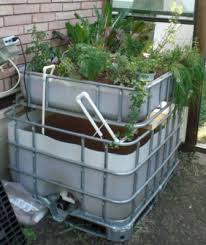In hydroponics, plants (tomato, chicory, ..) are cultured with their roots on or in water (or a substrate (layer) of ((expanded) clay) granules). Nutrients are metered into the water, which is refreshed regularly (weekly, lukewarm). The plants develop adapted and fine hair roots.
Aquaculture refers to the cultivation of fish and shellfish in basins. Through the secretion of the animals, the water is toxic and therefore unusable.
 Aquaponics (ponics, from the Greek ponein: labor, toil, also aquaponica) combines both systems to overcome the drawbacks of the one, to the advantage of the other in a symbiosis. It can be a durable ecosystem in which fish and plants are grown together as food.
Aquaponics (ponics, from the Greek ponein: labor, toil, also aquaponica) combines both systems to overcome the drawbacks of the one, to the advantage of the other in a symbiosis. It can be a durable ecosystem in which fish and plants are grown together as food.
Advantages:
Chemical agents are rarely used or not, because they are (possibly) a threat to the other part of the cycle (especially for fish and bacteria).
You do not have to hoe. There are little or no weeds.
The useful area is doubled (or x 3; 4) by hanging over the fish tank 1 (2 or 3) plateaus with crops.
Therefore you get a convenient working height,
And a high yield per area.
The water is in a closed circuit, and is not discharged (consumes and pollutes less).
The wastes of aquatic animals are essential nutrients for the plants. Microorganisms convert the poop of fish into nutrients for plants. In turn, the plants filter the water for the fish.
Nitrification is the aerobic conversion of ammonia to nitrate in a nitrogen cycle. Nitrosomonas sp. bacteria eat (for fish toxic) ammonia and convert it into less toxic nitrite. Nitrobacter sp. eats nitrite and converts it into nitrate, which plants thrive on. Booting of a system therefore also needs some time, the bacterial colonies should develop.
A (fresh) water culture system consists of at least one fish tank and one cultivation bed. Complex systems can operate with a cascade, pumps, sedimentation areas, bio filters, ...
The idea is not new. Due to a shortage of land the Aztecs used already floating gardens or Chinampa's (‘square of cane’). They were with fertile mud (from canals) filled rafts and were usually anchored with willows.
In South China, Thailand and Indonesia were successful combinations of farmed fish and rice paddy fields.
By the work of Dr. Mark McMurtry (New Alchemy Institute, and North Carolina State University), the idea spreads since 1997. In Bangladesh, the most populous country in the world, aquaponics was especially introduced because there was hardly control (possible) on the (excessive) use of chemicals during the production and preservation of food for human consumption.
The Caribbean island of Barbados launched an initiative to start aquaponics systems at home.
Today, the system not only allows entrance into the Hydro- and aquaculture, but also the ability of small-scale applications in the city gardening and self-sufficiency.
In practice, tilapia are the most popular fish species (tropical freshwater fish that eats plant foods). But also (silver and solar (Bidyanus bidyanus and (Lepomis gibbosus)) perch and catfish (Silurus glanis) are useful addition to snails, crayfish or shrimp.
There are three elements that come not self-evident from the fish food to the plants: potassium, calcium, and iron. For potassium, and calcium addition, the pH-value of the water is regularly checked. Iron is occasionally (every three months) given.
An aquaponics gardener should also be a compost master. Compost tea can be used for the nutrients to the plants in the system.
In addition to this supplement, it is important to keep delivery of food relatively constant.
Also care for good aeration, and remove settled solids (which are for the compost heap).
Two types of systems are used:
Seed beds in which the plants on substrate as a water-purifying reed bed via a pump and filter are irrigated. Nutrients, bacteria and even worms nest between the boulders, grains or fibers. Nutricients are supplied with a continuous flow, or through flooding and drainage as in an ebb and flow cycle.
Deep Water Culture works with floating polystyrene (EPS or Styrofoam) rafts for plants so the roots hang down into the water.
Problems with fungi or insects in the vegetation to be addressed biological, ex. by spraying garlic concentrate, pepper spray, and using beneficial insects.
A cycle of course only works if it can sustain itself. That is hardly the case as fish feed is made of (imported) (gene technology) soy or fish meal of catches by which we fish the seas empty.
Duckweed (Lemna) can feed fish. It is the smallest flowering plant on Earth, but it multiplies very fast and is full of protein. Excess worms of vermiculture (via the worm compost) and cultured fly larvae are also suitable.
Through the use of a composting toilet can you close the loop further.
It remains a form of agriculture. This system delivers no more than you put in to it. Vegetables still need a season in order to grow, and fish several years. Who supposes that in aquaponics suddenly weekly fish and vegetables can be harvested better in advance can adjust his expectations to reality.
Applications in large companies tend quickly to irresponsible production methods but aquaponics certainly offers opportunities for small-scale self-seers.
